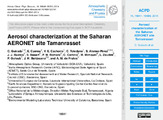Por favor, use este identificador para citar o enlazar este ítem:
http://hdl.handle.net/20.500.11765/6553
Aerosol characterization at the Saharan AERONET site Tamanrasset [Discussion paper]
| Título : | Aerosol characterization at the Saharan AERONET site Tamanrasset [Discussion paper] |
| Autor : | Guirado-Fuentes, Carmen





 ; Romero Campos, Pedro Miguel
; Romero Campos, Pedro Miguel


 ; Mimouni, Mohamed; Zeudmi, L.; Goloub, Philippe; Baldasano, José María; Frutos Baraja, Ángel Máximo de
; Mimouni, Mohamed; Zeudmi, L.; Goloub, Philippe; Baldasano, José María; Frutos Baraja, Ángel Máximo de |
| Palabras clave : | Partículas minerales; Aerosoles; AERONET; Aerosols; Mineral dust |
| Fecha de publicación : | 2014 |
| Editor: | European Geosciences Union |
| Citación : | Atmospheric Chemistry and Physics Discussions. 2014, 14, p. 16641–16690 |
| Versión del editor: | http://dx.doi.org/10.5194/acpd-14-16641-2014 |
| Resumen : | More than 2 years of columnar atmospheric aerosol measurements (2006–2009) at the Tamanrasset site (22.79° N, 5.53° E, 1377 m a.s.l.), in the heart of the Sahara, are analysed. Aerosol Robotic Network (AERONET) level 2.0 data were used. The KCICLO (K is the name of a constant and ciclo means cycle in Spanish) method was applied to a part of the level 1.5 data series to improve the quality of the results. The annual variability of aerosol optical depth (AOD) and Ångström exponent (AE) has been found to be strongly linked to the convective boundary layer (CBL) thermodynamic features. The dry-cool season (autumn and winter) is characterized by a shallow CBL and very low mean turbidity (AOD ~ 0.09 at 440 nm, AE ~ 0.62). The wet-hot season (spring and summer) is dominated by high turbidity of coarse dust particles (AE ~ 0.28, AOD ~ 0.39 at 440 nm) and a deep CBL. The aerosol-type characterization shows desert mineral dust as the prevailing aerosol. Both pure Saharan dust and very clear sky conditions are observed depending on the season. However, several case studies indicate an anthropogenic fine mode contribution from the industrial areas in Libya and Algeria. The concentration weighted trajectory (CWT) source apportionment method was used to identify potential sources of air masses arriving at Tamanrasset at several heights for each season. Microphysical and optical properties and precipitable water vapour were also investigated. |
| Patrocinador: | The AERONET sun photometer at Tamanrasset has been calibrated within AERONET-EUROPE TNA supported by the PHOTONS and RIMA networks and partially financed by the European Community – Research Infrastructure Action under the Seventh Framework Programme (FP7/2007-2013) “Capacities” specific programme for Integrating Activities, ACTRIS grant agreement no. 262254. Financial support from the Spanish MINECO (projects CGL2011-23413, CGL2012-33576 and CGL2012-37505) is also gratefully acknowledged. J. M. Baldasano and S. Basart acknowledge the Supercomputación y eCiencia project (CSD2007-0050) from the Consolider-Ingenio 2010 and Severo Ochoa (SEV-2011-00067) programs of the Spanish Government. |
| URI : | http://hdl.handle.net/20.500.11765/6553 |
| ISSN : | 1680-7367 1680-7375 |
| Colecciones: | Artículos científicos 2010-2014 |
Ficheros en este ítem:
| Fichero | Descripción | Tamaño | Formato | ||
|---|---|---|---|---|---|
| acpd-14-16641-2014.pdf | 4,38 MB | Adobe PDF |  Visualizar/Abrir |
Los ítems de Arcimis están protegidos por una Licencia Creative Commons, salvo que se indique lo contrario.





